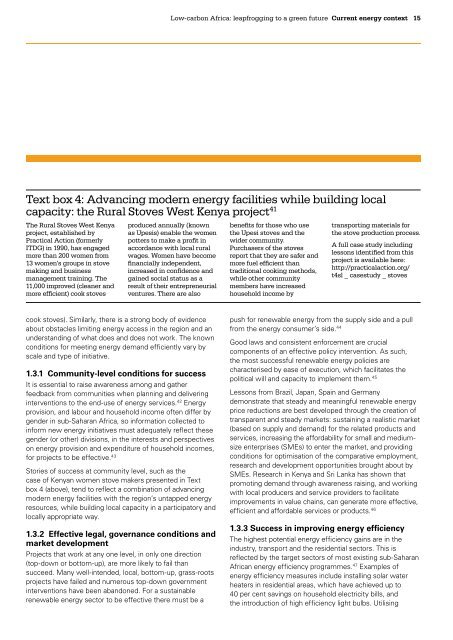Ju8uG
Ju8uG
Ju8uG
You also want an ePaper? Increase the reach of your titles
YUMPU automatically turns print PDFs into web optimized ePapers that Google loves.
Low-carbon Africa: leapfrogging to a green future Current energy context<br />
15<br />
Text box 4: Advancing modern energy facilities while building local<br />
capacity: the Rural Stoves West Kenya project 41<br />
The Rural Stoves West Kenya<br />
project, established by<br />
Practical Action (formerly<br />
ITDG) in 1990, has engaged<br />
more than 200 women from<br />
13 women’s groups in stove<br />
making and business<br />
management training. The<br />
11,000 improved (cleaner and<br />
more efficient) cook stoves<br />
produced annually (known<br />
as Upesis) enable the women<br />
potters to make a profit in<br />
accordance with local rural<br />
wages. Women have become<br />
financially independent,<br />
increased in confidence and<br />
gained social status as a<br />
result of their entrepreneurial<br />
ventures. There are also<br />
benefits for those who use<br />
the Upesi stoves and the<br />
wider community.<br />
Purchasers of the stoves<br />
report that they are safer and<br />
more fuel efficient than<br />
traditional cooking methods,<br />
while other community<br />
members have increased<br />
household income by<br />
transporting materials for<br />
the stove production process.<br />
A full case study including<br />
lessons identified from this<br />
project is available here:<br />
http://practicalaction.org/<br />
t4sl _ casestudy _ stoves<br />
cook stoves). Similarly, there is a strong body of evidence<br />
about obstacles limiting energy access in the region and an<br />
understanding of what does and does not work. The known<br />
conditions for meeting energy demand efficiently vary by<br />
scale and type of initiative.<br />
1.3.1 Community-level conditions for success<br />
It is essential to raise awareness among and gather<br />
feedback from communities when planning and delivering<br />
interventions to the end-use of energy services. 42 Energy<br />
provision, and labour and household income often differ by<br />
gender in sub-Saharan Africa, so information collected to<br />
inform new energy initiatives must adequately reflect these<br />
gender (or other) divisions, in the interests and perspectives<br />
on energy provision and expenditure of household incomes,<br />
for projects to be effective. 43<br />
Stories of success at community level, such as the<br />
case of Kenyan women stove makers presented in Text<br />
box 4 (above), tend to reflect a combination of advancing<br />
modern energy facilities with the region’s untapped energy<br />
resources, while building local capacity in a participatory and<br />
locally appropriate way.<br />
1.3.2 Effective legal, governance conditions and<br />
market development<br />
Projects that work at any one level, in only one direction<br />
(top-down or bottom-up), are more likely to fail than<br />
succeed. Many well-intended, local, bottom-up, grass-roots<br />
projects have failed and numerous top-down government<br />
interventions have been abandoned. For a sustainable<br />
renewable energy sector to be effective there must be a<br />
push for renewable energy from the supply side and a pull<br />
from the energy consumer’s side. 44<br />
Good laws and consistent enforcement are crucial<br />
components of an effective policy intervention. As such,<br />
the most successful renewable energy policies are<br />
characterised by ease of execution, which facilitates the<br />
political will and capacity to implement them. 45<br />
Lessons from Brazil, Japan, Spain and Germany<br />
demonstrate that steady and meaningful renewable energy<br />
price reductions are best developed through the creation of<br />
transparent and steady markets: sustaining a realistic market<br />
(based on supply and demand) for the related products and<br />
services, increasing the affordability for small and mediumsize<br />
enterprises (SMEs) to enter the market, and providing<br />
conditions for optimisation of the comparative employment,<br />
research and development opportunities brought about by<br />
SMEs. Research in Kenya and Sri Lanka has shown that<br />
promoting demand through awareness raising, and working<br />
with local producers and service providers to facilitate<br />
improvements in value chains, can generate more effective,<br />
efficient and affordable services or products. 46<br />
1.3.3 Success in improving energy efficiency<br />
The highest potential energy efficiency gains are in the<br />
industry, transport and the residential sectors. This is<br />
reflected by the target sectors of most existing sub-Saharan<br />
African energy efficiency programmes. 47 Examples of<br />
energy efficiency measures include installing solar water<br />
heaters in residential areas, which have achieved up to<br />
40 per cent savings on household electricity bills, and<br />
the introduction of high efficiency light bulbs. Utilising


